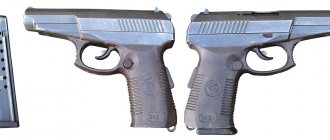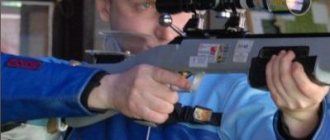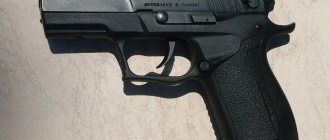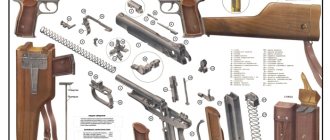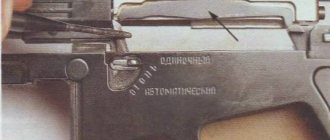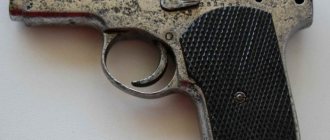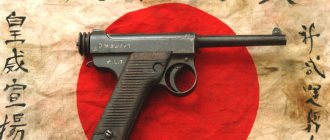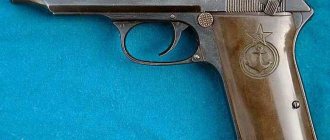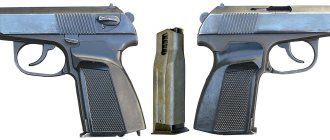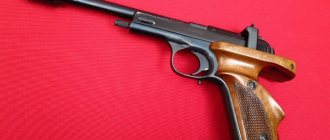The Soviet weapons designer Kalashnikov is famous for the pistol he developed. This page in the development of domestic weapons has remained little known. It is worth noting that this model was created to a high level of craftsmanship, but was not put into mass production. Nevertheless, she had important virtues and deserves to be known.
This is what the weapon looked like
The history of the creation of the Kalashnikov pistol
Kalashnikov is famous for the assault rifle he created. However, in 1950 he introduced an automatic pistol. This year there was a competition at which a decision was made on which pistol to adopt and put into mass production. Its competitors were Stechkin and Voevodin pistols.
At this time, it became clear that it was necessary to provide weapons to the crews of tanks, self-propelled guns, and various combat vehicles with personal weapons. The machine gun could not be used for this purpose due to its significant dimensions. Also, the Makarov pistol was not suitable due to its insufficient power. Therefore, it was necessary to create a new design. The Makarov pistol was adopted as this option.
At this time, two types of pistols were required. One of them had to meet the above requirements, the other was intended for use as a personal weapon for officers. In the latter case, the use of low-power weapons was allowed.
The history of the creation of this pistol began immediately after the end of the Great Patriotic War. The task was set to create a pistol that should be at the level of the world's best models or surpass them. Several design bureaus began to solve the problem. The technical specifications were prepared in 1945 by the Artillery Directorate of the Red Army.
During the war, accumulated combat experience showed that officers needed more advanced service weapons.
During the development, in particular, ideas were used that were used to create the German Walter MP assault pistol. Much attention was paid to changes to improve the manufacturability of weapons.
The Kalashnikov pistol was capable of not only conducting single fire, but also firing in bursts. At this time, the Soviet Union was skeptical about the use of automatic pistols, and the existing models did not satisfy the military.
The first tests showed the presence of serious shortcomings in the development. Improvements continued until 1951. Changes were made to the sight, the operation of the fire switching mode was adjusted, and the magazine capacity was increased by two rounds.
The competition was won by the Stechkin pistol, and the Kalashnikov model was sent to the museum shelf. Both design solutions were largely similar. They were completed with wooden holsters of approximately the same size. They were used as a butt. The pistol handles had special holders for their secure fastening. These devices helped increase shooting accuracy.
Both cartridges were contained in double-row magazines with a staggered arrangement. The Kalashnikov pistol was slightly lighter than its competitor (by 20 g) and shorter (by 3 mm). The Kalashnikov pistol did not have the ability to self-cock and did not use special fire retarders, unlike its more successful competitor. It is interesting to note that he did not even take part in field testing.
There are no known facts that would comprehensively explain what happened. When looking for the reasons for losing the competition, you can only rely on rumors. According to one of them, the designer is known to have lost interest in this topic due to his workload on other types of weapons. According to others, he was advised not to create competition for Stechkin. Both of these considerations have not been substantively confirmed, but no other information has been published about this.
This pistol was produced for several years and was discontinued in 1958. At the beginning of 1960, it was no longer used anywhere. In some cases, it remained in service until the 1980s.
In the seventies, a policy was adopted to use other types of personal weapons. A competition was announced for the creation of portable small-caliber assault rifles chambered for 5.45x39. The AKS-74U, developed by Kalashnikov, was adopted.
This is an unassembled weapon.
Performance characteristics
The table shows a comparison of the performance characteristics of pistols in service and the promising Lebedev model.
| PMM | PY | PL-15 | PL-15K | |
| Length, mm | 165 | 198 | 220 | 180 |
| Height, mm | 127 | 145 | 136 | 130 |
| Thickness, mm | 34 | 38 | 28 | |
| Barrel length, mm | 93,5 | 112,8 | 127 | |
| Chuck type | 9*18 | 9*19 | ||
| Magazine capacity, pcs. | 12 | 18 | 15 | 14 |
| Weight without cartridges, g | 760 | 950 | 800 | 720 |
| Curb weight, g | 880 | 995 | ||
Performance characteristics of the Kalashnikov pistol APK
This weapon, despite its high efficiency, had a very modest appearance. It was thoughtful. Although the pistol was not adopted for service, it was nevertheless made to a high level of craftsmanship. It is believed that Kalashnikov was very busy at that time working to improve his assault rifle and machine gun and was unable to pay enough attention to the development of the pistol.
Without ammunition, the weapon weighed 1.25 kg. If loaded, the weight including cartridges reached 1.7 kg.
Tactical and technical characteristics can be found in the following table.
| Characteristic | Meaning |
| Caliber | 9 mm |
| Chuck type used | 9x18 PM |
| Aimed firing range | 200 m |
| Magazine capacity | 18 rounds |
| Available types of shooting: | Single and automatic |
| Weight | 1250 g |
| Length | 222 mm |
| Height | 150 mm |
| Width | 34 mm |
| Bullet power | 494 Joules |
| Initial bullet speed | 420 m/s |
In 1951, a modified model was created. Structural changes have been made to it. In particular, its magazine was now designed to hold not 18, but 20 rounds. The pistol has become lighter: its weight has changed from 1.25 to 1.1 kg. The holster, which can also be used as a buttstock, was now made not of wood, but of plastic.
The effective range varies depending on the stock used. With it it reaches up to 200 m, and without it it does not exceed 50 m. The rate of fire with single shots is 35-40. When firing automatically, it reaches 200 rounds per minute.
Interesting Facts
Although the Lebedev pistol is not mass-produced, it is available in computer games. In the game Payday 2, the weapon appears under the designation White Streak. At the same time, the factory mark was replaced with a design in the form of a snowflake.
Serial production of the PL-15 was planned to begin in 2016.
Protracted development tests pushed back the date of adoption for an indefinite period. We can only hope that the pistol will not repeat the fate of Yarygin’s weapon, which has been in production for more than 15 years.
The current trend in the modern development of weapons in the Russian Federation also raises certain concerns, when advertised samples turn out to be crude and not suitable for military use.
Structure of the agro-industrial complex
Kalashnikov sought to create such a design to facilitate the production process of weapons. An important feature of the pistol was the ability to conduct not only single, but also automatic fire. A rotary hammer trigger mechanism was used as a striker. Unlike the Stechkin model, fire retarders are not used here.
In the pistol, the self-cocking trigger was disabled. For automatic fire, the recoil energy of the shutter was used. The energy of the exhaust powder gases forcefully threw the bolt back, as a result of which the cartridge case was extracted and a new cartridge was chambered. The return spring was placed on the barrel. Its length is half that of a similar part of the Stechkin pistol.
Using a holster.
The cartridges were in a two-row magazine. They were located inside in a checkerboard pattern. There was no provision for self-cocking.
The safety not only blocks the weapon, but also switches between single or automatic fire. It is located on the left side. When installing the safety, the trigger was smoothly released, and the pistol was released from the cocking position. It is noted that the design of the pistol was highly reliable.
This design is considered simpler and more reliable compared to other automatic pistols. While working on it, Kalashnikov wanted to try his hand at a new direction. Some believe that the loss of Stechkin’s model was due to the fact that the designer at that time was busy working on improving his machine gun. Kalashnikov is famous not only for the creation of the submachine gun and pistol, but also the machine gun, carbine and sniper rifle.
The trigger has a round head. This is useful for increasing the speed at which the pistol can be drawn from the holster. This is also helped by the smoothed contours of the weapon.
Advantages and disadvantages of the model
This pistol has important advantages:
- High shooting accuracy.
- Good rate of fire.
- No use of retardants.
- Simplicity and reliability of the design.
- Manufacturability in manufacturing.
During operation, the following shortcomings were noted:
- The wooden stock, which is convenient to use for accurate shooting, is too massive. It is not convenient for use in a tank or combat vehicle.
- The ability to conduct automatic fire was in little demand - it only created additional difficulties.
- The configuration included 4 fully loaded magazines, which was quite a heavy load. They had to be carried in pouches.
- Experts believe that a pistol without self-cocking was not suitable for special forces personnel. This quality increased the safety of using weapons. But it reduced the effectiveness of shooting where it was necessary to act quickly.
- Compared to the Stechkin pistol, the number of cartridges in the magazine was 2 less.
- Without the stock, the sighting range did not exceed 50 m.
Also disadvantages include the use of appropriate cartridges. Due to its mechanical characteristics, the bullet could not gain good speed, which significantly reduced its penetrating power.
Advantages and disadvantages
High targeting
Good accuracy
High sighting range when using a wooden holster as a buttstock.
Simplicity and reliability
Manufacturability
No self-cocking
Short range without using a stock
Bulky for use by crews of tanks and combat vehicles
Fewer rounds compared to competitors
Combat and sports modifications
The Kalashnikov concern, already two years after the presentation of the PL-14, began to talk about this version only as a prototype. The basic version of the combat pistol is considered to be its significantly modified modification called PL-15, as well as the compact version of this pistol PL-15K.
However, in the modification of the PL-15, it was decided to return to the originally intended “lightweight” characteristics of the trigger mechanism: single action, with significantly less force on the trigger (25N and a 4-mm hook stroke). In addition, the back of the pistol was slightly changed, the safety levers received a slightly different shape, and a hole for a strap appeared on the handle.
At the same time, the PL-15K variant provides for its release with two USM options. In general, further possible modifications of the Lebedev pistol with an extended barrel and threads for installing a silencer. The manufacturer also considers it very likely that some pistols will be produced with a plastic frame, and some with a metal frame.
In 2022, a new sports modification of Lebedev’s pistol was introduced, designated SP1. It is intended for amateur shooters. The SP1 version of the submarine was equipped with removable open sights of the Glock standard. Versions PL-15 and PL-15K were presented as potential weapons of the Russian Guard, changing their names to MPL-1 and MPL-2, respectively.
Pistols PL-15 (right) and PL-15K (left)
Ammunition for Kalashnikov automatic pistol
At the time the weapon was created, the 9x18 cartridge was newly developed. It was created by Semin's design bureau. The 9 mm caliber and 18 mm long sleeve were developed at AKB-44 (nowadays it is called TsNIITOCHMASH). The first batch was manufactured and transferred for testing in 1947.
9x18 cartridges
At this time, production was successfully established. It had an effective stopping effect. There were no storage problems for such a cartridge. Its disadvantage was its weak armor-piercing effect. Such a cartridge could not be used against an enemy using body armor. This was due to the low initial speed of the bullet, associated with the peculiarities of its shape. When using such cartridges indoors, there was a high risk of ricochet.
Disassembling a Kalashnikov automatic pistol
Disassembling a pistol can be of two types: incomplete and complete. In the first case, it is used to clean and lubricate the weapon. It is also necessary for a complete inspection of the condition of the automatic pistol. Complete disassembly is required in cases where there has been significant contamination of the weapon that has penetrated inside. It is used when repairs need to be made. It is required when switching from summer to winter lubrication or vice versa.
When disassembling, it is mandatory to comply with the following rules:
- If possible, the procedure is performed on the table. If it or a bench is not available, then this can be done by laying out the parts on a clean cloth placed on the ground.
- When disassembling, the parts are laid out on a clean surface in the same order in which they were removed. When reassembling, take them in reverse order. This helps reduce the risk of errors during the procedure and reduce the time it takes to complete it.
- In the process of assembly. If it happens at the same time as others, it is important to pay attention to the numbers. It is important. To prevent the use of parts belonging to other weapons.
Next we will talk about carrying out incomplete disassembly. It is done as follows:
- You need to remove the magazine from the pistol. In this case, the weapon is held with the right hand and pulled out with the left.
- You need to make sure that there is no cartridge in the chamber. This is important to exclude the possibility of spontaneous firing. To do this, hold the weapon with your right hand and set the switch to the single-fire position with your left. Then cock the hammer and pull the cartridge back. If there is no cartridge, the bolt can be released.
- The shutter is separated from the frame. To do this, pull the trigger forward and the trigger guard down.
- With your left hand, move the bolt to the rear position and lift the rear end. Then it is separated from the frame.
- Then the return spring is removed from the barrel.
Kalashnikov pistol
This will complete the partial disassembly. Reassembly is carried out in reverse order by performing the following steps:
- First, take the handle in your right hand. Then a return spring is put on the barrel.
- Attach the shutter to the frame. In this case, the frame is held with the right hand, and the bolt is put on with the left hand from the side of the barrel, inserting a spring into the bolt channel. After this, the bolt is retracted all the way back. This must be done so that the muzzle part protrudes outward. Now the rear part of the shutter is lowered down so that the longitudinal protrusions correspond to the desired grooves in the frame. Pressing it against the frame, the part is released. After that it falls into place.
- Press the trigger guard upward with your index finger. This is necessary so that this part takes the correct position. During this action, you need to hold the trigger with your thumb. This is necessary so that it smoothly takes the desired position.
- The magazine is inserted into the base of the handle, but not all the way.
- While holding the pistol with your right hand, set the safety lever with your left to a position in which it blocks firing.
- Now the store is being pushed all the way in. After this, press it with your thumb so that the magazine latch takes the correct position.
At the final stage, it is not allowed to hit the magazine with your palm so that it goes in completely. After completing the assembly, you need to make sure that no errors were made during the procedure. To do this, perform the appropriate check.
- To do this, the switch is set to the single-fire position.
- The shutter is pulled back to the limit and released. At the same time, it will move forward a little and then stop in the rear position.
- Press the shutter stop. After this, the shutter will vigorously move to the forward position. The trigger will remain cocked.
- The fuse is set to the blocking position. After this, the trigger will move to the non-combat position and will be locked.
If the test is successful, then the automatic pistol was assembled correctly.
Kalashnikov pistol
